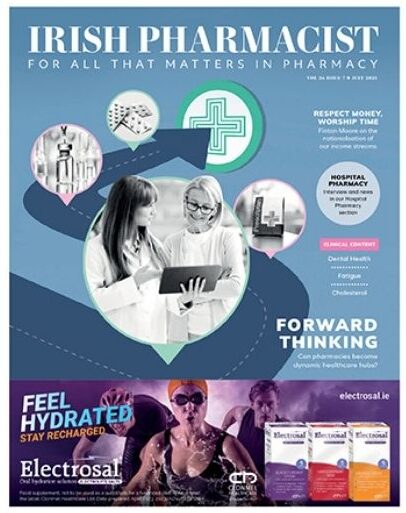Stress and fatigue are natural consequences of life but there are ways to combat them, writes Eamonn Brady MPSI
Everyone can feel they are a little lethargic from time-to-time. Our busy lives are often a factor. However, there are many other possible medical reasons, such as insomnia, low thyroid or iron levels, depression or even prescription medication, such as beta blockers. The key factors that ensure we have enough energy are a healthy diet, regular exercise, sufficient sleep, and keeping stress to a minimum. I will discuss some of these.
Food for thought
Diet is one of the biggest influences on wellbeing and alertness. Everyone has heard the general advice of ‘follow a balanced diet’, so in this article I will simply give a few small tips that can help our patients when advising them.
Oatmeal
Oatmeal is a low GI food, which means it releases energy slowly. Therefore, porridge is an ideal start to the day, as there is less risk of getting hungry before lunch and it reduces risk of an energy lull mid-morning or later in the day. GI stands for ‘glycaemic index’ and is a measure of the impact of food on blood sugar. Foods with a high GI will raise the body’s blood sugar levels quickly; by contrast, foods with a low GI will raise them more slowly and over a longer period.
High GI foods such as sugary drinks, white bread or chips give a fast rush of energy, followed by an energy lull. High GI foods are associated with getting hungry quicker and wanting to eat more. Aim for foods that have a low or moderate GI count, such as oats, pulses and wholemeal varieties of bread and rice.
Coffee
Limiting coffee intake to two cups per day can be very beneficial for energy levels. Coffee without sugar is calorie-free. Coffee stimulates the mind and makes us more productive at work. It is important to drink plenty of water when drinking coffee, as coffee is a mild diuretic and can cause dehydration. Drinking more than two cups of coffee per day is counterproductive, as it causes withdrawal symptoms, one of which includes fatigue. The same is true when drinking too much tea.
Bananas
Bananas are fat-free. They are rich in vitamin B6, potassium, vitamin C and fibre. They are an ideal healthy snack for a sugar craving, as they taste great and contain plenty of carbohydrates, the body’s main source of energy. Other fruits such as grapes, apples and watermelon are also fat-free, energising snacks which are full of nutrients.
Water
Staying hydrated is important to ensure all our nutrients are absorbed properly. Water also means we can release heat by sweating. Dehydration causes fatigue. In a climate like Ireland, we should aim to drink about six-to-eight glasses of water per day (approx 1.2 litres) to prevent dehydration. More is needed on hotter days and in hotter climates.
Lunch
If experiencing fatigue or a dip in energy after lunch, a change of what is eaten for lunch may help. High-protein lunches appear to produce greater alertness and more focused attention, whereas lunches that are high in fat tend to lead to greater fatigue, sleepiness, and distraction. Chicken, tuna, lean beef, and eggs are examples of lunch options that are high in protein and low in fat.
Use alcohol in moderation
Too much alcohol will reduce energy levels. It robs the body of vital vitamins, especially B vitamins, which play an important part of releasing energy from food. In excess, it causes high blood pressure, and its diuretic action can dehydrate the body, causing tiredness and headache. Moderation is the key. A good tip is to drink a glass of water in between each alcoholic drink, as it will not only reduce the risk of a hangover, but it will keep energy levels up.
Taking a look at sugar intake
It is easy to normalise eating habits which are causing daily damage. Too much caffeine, saturated fat and alcohol is no good for the body and too little exercise is not going to help with long-term mobility, flexibility, and good health. Sugar is something we tend to have too much of, and it has an addictive quality; evidence in recent years has proven too much sugar is more dangerous for our health than too much fat. Lowering sugar in our diet can not only be positive to overall health, in the shorter term it can have a big influence on our mood and energy levels.
How much sugar am I ‘allowed’ daily?
When setting dietary goals, keep them simple and start with sugar intake. The maximum recommended intake of added sugar is six teaspoons a day (24g). If adding sugar to tea and coffee, this amount will be reached very quickly. If someone takes sugar in the likes of tea or coffee, use brown sugar rather than white sugar, as it is less refined, so less is absorbed into the bloodstream. Better again, try taking an artificial sweetener, as it does not affect blood sugar levels in the same way as refined sugar and has zero calories.
Being familiar with sugar content of foods
How can someone tell how much sugar a product contains? Look at the food label relating to 100g of the product, and anything under 5g of sugar per 100g is a low-sugar product. To see how much sugar the actual product contains ie, cereal bar, look at the food label and it will give an amount of carbohydrate in grams and just below it will state ‘of which is sugars’ in grams also. Each teaspoon of sugar weighs 4g, so if it states 8g per bar, it means that the product contains two teaspoons of sugar. This gives a good mental image of how much sugar is in a product.
The main part of the diet should contain natural, unprocessed foods with their own enzymes to aid digestion and provide the body with the nutrients it requires. There are a lot of hidden sugars in processed food, so take a look at what is being consumed. There is a lot of food we consume that has obvious sugar — a can of Coke contains over eight teaspoons, and an average portion of most cakes contains between seven and 10 teaspoons. Sugar contains empty calories, as it provides the body with zero nutrition. The sugar in fruit is natural and does not affect the blood sugar levels in the same way as refined sugar.
It is important that we keep the blood sugar level stable with our food choices. Choose to snack on foods that contain protein and carbohydrates in preference to sugary snacks to keep blood sugar levels stable. If we constantly snack on sugary foods, there will always be a high level of insulin in the blood, which can cause many problems. Exercise naturally brings down blood sugar levels, so exercise regularly.
Sugar causes more ‘downs’ than ‘ups’
As mentioned earlier, high GI foods like sugars are associated with getting hungry quicker and wanting to eat more. Sugary foods and drinks give quick bursts of energy followed by a big crash, thus increasing general fatigue and lethargy. A lot of sugar has a negative effect of mood too.
Exercise
Exercise will help shake-off any cobwebs and make us feel more energised. Exercise has been proven to improve mood by stimulating ‘good mood’ hormones in the brain, such as serotonin. Starting exercise plans is more common at the start of the year when people are making New Year resolutions; here are some of the common mistakes people make when planning to exercise more.
Mistake 1: Unrealistic Goals
People tend to be very impatient when it comes to exercise and losing weight. Unless the goal is to lose only a pound or two, it may take a while to achieve the ideal healthy weight, and goals should reflect this fact. Having a weekly target will help keep focus.
Mistake 2: Not doing something we enjoy
Do things you enjoy to exercise. Do not feel the need to do exercises that are not enjoyable. Pick something that you find fun, ie, swimming, rollerblading, skipping, cycling. Everyone is different, so pick something that you enjoy, thus increasing the chances of sticking with it. Many people find team sports or group activities such as spin classes, five-a-side soccer, or tag rugby more enjoyable and a great way to meet new people. Try music, for example, a mini-MP3 player to listen to while jogging. People who exercise to music report exercising longer and more vigorously than those who do not.
Mistake 3: Failing to plan
As Roy Keane famously said, “fail to prepare, prepare to fail”. If the exercise regimen is not planned, people are less likely to keep it up. Plan set days of the week to exercise and try to stick with these (no matter how tired we feel after work!). The plan should take account of current fitness and a fitness level one would like to achieve. It should consider the amount of free time the person has, and any injuries or ailments to work around. Even if a person has very little time to exercise due to juggling work and family, etc, even 10 minutes twice a day can make a difference.
Mistake 4: No exercise variety
Varying exercise will avoid boredom and will allow a person to lose weight quicker and get fitter quicker. Varying exercise allows more muscles to be used and means more overall strength. For example, if a person normally only runs to exercise, why not break it up with a swim, a cycle, or a Pilates class.
Mistake 5: Doing it all alone
Find an exercise partner. People who exercise with a partner or group are more likely to stick with a regular routine. Involve family members and friends. People are less likely to skip a workout if they know somebody else is counting on them.
Mistake 6: No warm-up and cool-down
Warming-up prepares the body for the activity and intensity of activity ahead and prevents injury. Cooling down helps:
- Muscles get rid of waste (such as lactic acid).
- Decrease the heart rate slowly.
- Prevent blood pressure drops, which cause dizziness or fainting.
- Re-circulate blood from working muscles to the rest of the body.
- Prevent post-workout stiffness or soreness.
An example is walking for five minutes before jogging or lifting very light weights as a warm-up for more strenuous lifting.
Mistake 7: Training at the same intensity
This mistake typically takes one of two forms; training with too low an intensity all the time, or training with too high an intensity all the time.
Mistake 8: Using improper technique
- Do some homework — find out what the right technique is.
- The NHS website has good advice.
- Get help from a professional (such as a trainer or coach).
- Check technique periodically to make sure everything is as it should be.
- Staff at local gyms can give excellent advice on exercise regimen and techniques.
Mistake 9: Not rewarding yourself
Set weekly exercise goals and reward yourself at the end of the week when these are achieved. Rewards in this Covid era can be as simple as a new book or magazine, a cinema trip, new clothes, new make-up, or a massage.
Mistake 10: Not resting enough
Rest has a vital role to play in life and in exercise and getting the mix of activity and rest right is vital in both.
Common signs of over-training include:
- Injury.
- Irritation.
- Insomnia.
- Fatigue.
- Disinterest in exercise.
Sleep
Ensuring enough sleep may sound obvious but many Irish people are not getting sufficient sleep. Many people cannot get enough sleep for medical reasons, with about 40,000 Irish people suffering from chronic insomnia. However, many are not getting enough sleep quite simply due to not going to bed on time. Sleep requirements vary from person-to-person, and it varies from six-to-nine hours. However, most people need up to eight hours’ sleep. The amount of sleep needed does reduce with age.
Could a medical condition be causing tiredness?
If experiencing overwhelming or persistent tiredness, blood tests may need to be done to rule out other conditions, such as anaemia (low iron), haemochromatosis (too much iron), underactive thyroid, and liver and kidney problems. Chronic fatigue syndrome (CFS) is another possibility.
What about depression?
Feeling sad or ‘depressed’ happens to everyone from time-to-time. The sensation passes quickly for most people. However, for a person with clinical depression, the low feeling lasts for a longer period of time and can interfere with their daily life. Depression is caused by an imbalance of chemicals in the brain. These chemicals include serotonin and noradrenalin, which are involved in mood.
The reason why certain people develop depression is not fully understood, but there is a genetic influence, meaning that it tends to run in families. Stressful life events such as a bereavement of someone close, relationship breakdowns, etc, can trigger depression. Alcohol and certain drugs can also trigger depression. Feeling very fatigued and lethargic can sometimes be a sign of low mood or depression.







